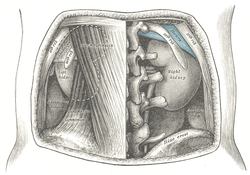Quadratus lumborum
| Quadratus lumborum muscle | |
|---|---|

The relations of the kidneys from behind. (Quadratus lumborum visible at lower left.)
|
|

Muscles of the posterior abdominal wall (Quadratus lumborum visible at bottom left.)
|
|
| Details | |
| Origin | iliac crest and iliolumbar ligament |
| Insertion | Last rib and transverse processes of lumbar vertebrae |
| Artery | Lumbar arteries, lumbar branch of iliolumbar artery |
| Nerve | The twelfth thoracic and first through fourth ventral rami of lumbar nerves (T12, L1-L4) |
| Actions | Alone(unilateral), lateral flexion of vertebral column; Together (bilateral), depression of thoracic rib cage |
| Identifiers | |
| Latin | musculus quadratus lumborum |
| TA | A04.5.01.027 |
| FMA | 15569 |
|
Anatomical terms of muscle
[]
|
|
The quadratus lumborum is a muscle of the posterior abdominal wall. It is the deepest abdominal muscle and commonly referred to as a back muscle. It is irregular and quadrilateral in shape and broader below than above.
It originates via aponeurotic fibers into the iliolumbar ligament and the internal lip of the iliac crest for about 5 cm. It inserts from the lower border of the last rib for about half its length and by four small tendons from the apices of the transverse processes of the upper four lumbar vertebrae.
Occasionally, a second portion of this muscle is found in front of the preceding. It arises from the upper borders of the transverse processes of the lower three or four lumbar vertebræ, and is inserted into the lower margin of the last rib.
Anterior to the quadratus lumborum are the colon, the kidney, the psoas major and (if present) psoas minor, and the diaphragm; between the fascia and the muscle are the twelfth thoracic, ilioinguinal, and iliohypogastric nerves. Quadratus lumborum is a continuation of transverse abdominal muscle.
The number of attachments to the vertebræ and the extent of its attachment to the last rib vary.
Anterior branches of the ventral rami of T12 to L4.
The quadratus lumborum can perform four actions:
The quadratus lumborum, or QL, is a common source of lower back pain. Because the QL connects the pelvis to the spine and is therefore capable of extending the lower back when contracting bilaterally, the two QLs pick up the slack, as it were, when the lower fibers of the erector spinae are weak or inhibited (as they often are in the case of habitual seated computer use and/or the use of a lower back support in a chair). Given their comparable mechanical disadvantage, constant contraction while seated can overuse the QLs, resulting in muscle fatigue. A constantly contracted QL, like any other muscle, will experience decreased blood flow, and, in time, adhesions in the muscle and fascia may develop, the end point of which is muscle spasm.
...
Wikipedia
